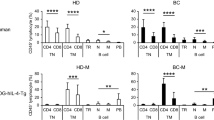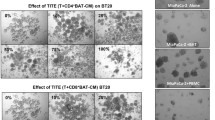Abstract
In this study, we developed a unique in vitro model to mimic the endogenous tumor microenvironment to understand the effect of immunotherapy with activated T-cells (ATC) armed with anti-CD3 × anti-Her2 bispecific antibody (aATC) on antibody response by naive immune cells. This model contained a co-culture of naïve peripheral blood mononuclear cells (PBMC), breast cancer cells (SK-BR-3), ATC or aATC and CpG ODNs. Culture supernatants were tested at various time points for anti-SK-BR-3 antibodies by ELISA, Western blot and flow cytometry. PBMC cocultured with non-irradiated aATC or irradiated (*) aATC showed significant increases in anti-tumor antibody production at day 14 (P < 0.0001) in the presence of CpG-ODN compared to unstimulated PBMC cultures (n = 9). Antibody specificity was confirmed by ELISA, Western blot and flow cytometry. Co-cultures containing *aATC and CpG showed significantly enhanced levels of IgG2 (P < 0.001) and cytokines that promote IgG2 synthesis including IL-13 (P < 0.02), IFNγ (P < 0.01) and GM-CSF (P < 0.05) compared to unstimulated PBMC control (n = 3). We show that aATC targeting and lysis of tumor cells induces an anti-tumor antibody response in our in vitro model. This model provides a unique opportunity to evaluate the interactions of T-cells, B-cells, and antigen-presenting cells leading to specific anti-tumor antibody responses.








Similar content being viewed by others
References
Jinushi M, Hodi FS, Dranoff G (2006) Therapy-induced antibodies to MHC class I chain-related protein A antagonize immune suppression and stimulate antitumor cytotoxicity. Proc Natl Acad Sci USA 103(24):9190–9195
Wu CJ, Yang XF, McLaughlin S et al (2000) Detection of a potent humoral response associated with immune-induced remission of chronic myelogenous leukemia. J Clin Invest 106(5):705–714
Bhardwaj N (2007) Harnessing the immune system to treat cancer. J Clin Invest 117(5):1130–1136
Grabert RC, Cousens LP, Smith JA et al (2006) Human T cells armed with Her2/neu bispecific antibodies divide, are cytotoxic, and secrete cytokines with repeated stimulation. Clin Cancer Res 12(2):569–576
Cobleigh MA, Vogel CL, Tripathy D et al (1999) Multinational study of the efficacy and safety of humanized anti-HER2 monoclonal antibody in women who have HER2-overexpressing metastatic breast cancer that has progressed after chemotherapy for metastatic disease. J Clin Oncol 17(9):2639–2648
Vogel CL, Cobleigh MA, Tripathy D et al (2002) Efficacy and safety of trastuzumab as a single agent in first-line treatment of HER2-overexpressing metastatic breast cancer. J Clin Oncol 20(3):719–726
Marty M, Cognetti F, Maraninchi D et al (2005) Randomized phase II trial of the efficacy and safety of trastuzumab combined with docetaxel in patients with human epidermal growth factor receptor 2-positive metastatic breast cancer administered as first-line treatment: The M77001 study group. J Clin Oncol 23(19):4265–4274
Clynes RA, Towers TL, Presta LG, Ravetch JV (2000) Inhibitory Fc receptors modulate in vivo cytoxicity against tumor targets. Nat Med 6(4):443–446
Dhodapkar KM, Dhodapkar MV (2005) Recruiting dendritic cells to improve antibody therapy of cancer. Proc Natl Acad Sci USA 102(18):6243–6244
Dhodapkar KM, Kaufman JL, Ehlers M et al (2005) Selective blockade of inhibitory Fc gamma receptor enables human dendritic cell maturation with IL-12p70 production and immunity to antibody-coated tumor cells. Proc Natl Acad Sci USA 102(8):2910–2915
Dhodapkar MV (2005) Harnessing host immune responses to preneoplasia: promise and challenges. Cancer Immunol Immunother 54(5):409–413
DiFronzo LA, Gupta RK, Essner R et al (2002) Enhanced humoral immune response correlates with improved disease-free and overall survival in American joint committee on cancer stage II melanoma patients receiving adjuvant polyvalent vaccine. J Clin Oncol 20(15):3242–3248
Riethmuller G, Kufer P (1998) Minimal residual cancer: a target for antibody-based strategies. Naunyn-Schmiedebergs. Arch Pharmacol 358(1):R197
Riethmuller G, Holz E, Schlimok G et al (1998) Monoclonal antibody therapy for resected Dukes’ C colorectal cancer: seven-year outcome of a multicenter randomized trial. J Clin Oncol 16(5):1788–1794
Jung J, Yi AK, Zhang X, Choe J, Li L, Choi YS (2002) Distinct response of human B cell subpopulations in recognition of an innate immune signal, CpG DNA. J Immunol 169(5):2368–2373
Klinman DM, Yi AK, Beaucage SL, Conover J, Krieg AM (1996) CpG motifs present in bacterial DNA rapidly induce lymphocytes to secrete interleukin 6, interleukin 12, and interferon gamma. Proc Natl Acad Sci USA 93(7):2879–2883
Krieg AM, Yi AK, Matson S et al (1995) Cpg motifs in bacterial-Dna trigger direct B-cell activation. Nature 374(6522):546–549
Krieg AM (2002) CpG motifs in bacterial DNA and their immune effects. Annu Rev Immunol 20:709–760
Davis HL, Weeranta R, Waldschmidt TJ, Tygrett L, Schorr J, Krieg AM (1998) CpG DNA is a potent enhancer of specific immunity in mice immunized with recombinant hepatitis B surface antigen. J Immunol 160(2):870–876
Carpentier AF, Capelle L, Carpentier A et al (2005) Phase I trial of CpG ODN in recurrent glioblastoma. Clin Cancer Res 11(24):9124S
Friedberg JW, Kim H, McCauley M et al (2005) Combination immunotherapy with a CpG oligonucleotide (1018 ISS) and rituximab in patients with non-Hodgkin lymphoma: increased interferon-alpha/beta-inducible gene expression, without significant toxicity. Blood 105(2):489–495
Link BK, Ballas ZK, Weisdorf D et al (2006) Oligodeoxynucleotide CpG 7909 delivered as intravenous infusion demonstrates immunologic modulation in patients with previously treated non-Hodgkin lymphoma. J Immunother 29(5):558–568
Reusch U, Sundaram M, Davol PA et al (2006) Anti-CD3 x anti-epidermal growth factor receptor (EGFR) bispecific antibody redirects T-cell cytolytic activity to EGFR-positive cancers in vitro and in an animal model. Clin Cancer Res 12(1):183–190
Gall JM, Davol PA, Grabert RC, Deaver M, Lum LG (2005) T cells armed with anti-CD3 x anti-CD20 bispecific antibody enhance killing of CD20(+) malignant B cells and bypass complement-mediated rituximab resistance in vitro. Exp Hematol 33(4):452–459
Lum LG, Orcuttthordarson N, Seigneuret MC, Hansen JA (1982) Invitro regulation of immunoglobulin-synthesis by T-cell sub-populations defined by a new human T-cell antigen (9.3). Cell Immunol 72(1):122–129
Lum LG, Orcuttthordarson N, Seigneuret MC, Storb R (1982) The regulation of Ig synthesis after marrow transplantation.4. T4 and T8 Subset function in patients with chronic graft-vs-host disease. J Immunol 129(1):113–119
Lee JCW, Cevallos AM, Naeem A, Lennard-Jones JE, Farthing MJG (1999) Detection of anti-colon antibodies in inflammatory bowel disease using human cultured colonic cells. Gut 44(2):196–202
Maple L, Lathrop R, Bozich S et al (2004) Development and validation of ELISA for Herceptin detection in human serum. J Immunol Methods 295(1–2):169–182
Groh V, Lil YQQ, Cioca D et al (2005) Efficient cross-priming of tumor antigen-specific T cells by dendritic cells sensitized with diverse anti-MICA opsonized tumor cells. Proc Natl Acad Sci USA 102(18):6461–6466
Chomarat P, Dantin C, Bennett L, Banchereau J, Palucka AK (2003) TNF skews monocyte differentiation from macrophages to dendritic cells. J Immunol 171(5):2262–2269
Iwamoto S, Iwai S, Tsujiyama K et al (2007) TNF-alpha drives human CD14(+) monocytes to differentiate into CD70(+) dendritic cells evoking Th1 and Th17 responses. J Immunol 179(3):1449–1457
Vitale M, la Chiesa M, Carlomagno S et al (2005) NK-dependent DC maturation is mediated by TNF alpha and IFN gamma released upon engagement of the NKp30 triggering receptor. Blood 106(2):566–571
Smith KE, Janelidze S, Visse E et al (2007) Synergism between GM-CSF and IFN gamma: Enhanced immunotherapy in mice with glioma. Int J Cancer 120(1):75–80
Aversa G, Cocks B, Punnonen J et al (1993) Il-13-induced B-cell proliferation and Ige synthesis is blocked by an Il-4 mutant protein—support for a shared component of the Il-4 and Il-13 receptors. J Leukoc Biol 93
Kopf M, Ramsay A, Brombacher F et al (1995) Pleiotropic defects of IL-6-deficient mice including early hematopoiesis, T and B cell function, and acute phase responses. Interleukin-6 Type Cytokines 762:308–318
Kopf M, Herren S, Wiles MV, Pepys MB, Kosco-Vilbois MH (1998) Interleukin 6 influences germinal center development and antibody production via a contribution of C3 complement component. J Exp Med 188(10):1895–1906
Lai YH, Mosmann TR (1999) Mouse IL-13 enhances antibody production in vivo and acts directly on B cells in vitro to increase survival and hence antibody production. J Immunol 162(1):78–87
Mckenzie ANJ, Culpepper JA, Malefyt RD et al (1993) Interleukin-13, a T-cell-derived cytokine that regulates human monocyte and B-cell function. Proc Natl Acad Sci USA 90(8):3735–3739
Morse MA, Lyerly HK, Li YW (1999) The role of IL-13 in the generation of dendritic cells in vitro. J Immunother 22(6):506–513
Sato K, Nagayama H, Tadokoro K, Juji T, Takahashi TA (1999) Interleukin-13 is involved in functional maturation of human peripheral blood monocyte-derived dendritic cells. Exp Hematol 27(2):326–336
Lum LG, Seigneuret MC, Storb RF, Witherspoon RP, Thomas ED (1981) In vitro regulation of immunoglobulin synthesis after marrow transplantation I. T-cell and B-cell deficiencies in patients with and without chronic graft-versus-host disease. Blood 58:431–439
Lum LG, Seigneuret MC, Orcutt-Thordarson N, Noges JE, Storb R (1985) The regulation of immunoglobulin synthesis after HLA-identical bone marrow transplantation: VI. Differential rates of maturation of distinct functional groups within lymphoid subpopulations in patients after human marrow grafting. Blood 65:1422–1433
Waldmann TA, Korsmeyer SJ, Hieter PA, Ravetch JV, Broder S, Leder P (1983) Regulation of the humoral immune-response—from immunoglobulin genes to regulatory T-cell networks. Fed Proc 42(8):2498–2503
Amoroso K, Lipsky PE (1990) Frequency of human B-cells that differentiate in response to anti-cd3-activated T-cells. J Immunol 145(10):3155–3161
Lipsky PE (1990) The induction of human B-cell activation, proliferation and differentiation by anti-cd3-stimulated T-cells—a model of T-cell B-cell collaboration. Res Immunol 141(4–5):424–427
Bisikirska B, Colgan J, Luban J, Bluestone JA, Herold KC (2005) TCR stimulation with modified anti-CD3 mAb expands CD8(+) T cell population and induces CD8(+)CD25(+) Tregs. J Clin Invest 115(10):2904–2913
Sampson JH, Crotty LE, Lee S et al (2000) Unarmed, tumor-specific monoclonal antibody effectively treats brain tumors. Proc Natl Acad Sci USA 97(13):7503–7508
Yang XF, Wu CJ, McLaughlin S et al (2001) CML66, a broadly immunogenic tumor antigen, elicits a humoral immune response associated with remission of chronic myelogenous leukemia. Proc Natl Acad Sci USA 98(13):7492–7497
Reilly RT, Machiels JPH, Emens LA et al (2001) The collaboration of both humoral and cellular HER-2/neu-targeted immune responses is required for the complete eradication of HER-2/neu-expressing tumors. Cancer Res 61(3):880–883
Park JM, Terabe M, Sakai Y et al (2005) Early role of CD4(+) Th1 cells and antibodies in HER-2 adenovirus vaccine protection against autochthonous mammary carcinomas. J Immunol 174(7):4228–4236
Acknowledgments
These studies were funded in part by R01 CA 092344 (L.G.L.), R01 CA 140412 (L.G.L), 5P39 CA 022453 from National Cancer Institute, Translational Grants #6066-06 and #6092-09 from the Leukemia and Lymphoma Society (L.G.L), Susan G. Komen Foundation Translational Grant #BCTR0707125 (L.G.L), and Michigan Cell Therapy Center for Excellence Grant from the State of Michigan #1819, and startup funds from the Barbara Ann Karmanos Cancer Institute.
Conflict of interest
The authors have no financial conflict of interest. L.G.L. is a founder of Transtarget, Inc.
Author information
Authors and Affiliations
Corresponding author
Rights and permissions
About this article
Cite this article
Thakur, A., Norkina, O. & Lum, L.G. In vitro synthesis of primary specific anti-breast cancer antibodies by normal human peripheral blood mononuclear cells. Cancer Immunol Immunother 60, 1707–1720 (2011). https://doi.org/10.1007/s00262-011-1056-9
Received:
Accepted:
Published:
Issue Date:
DOI: https://doi.org/10.1007/s00262-011-1056-9




